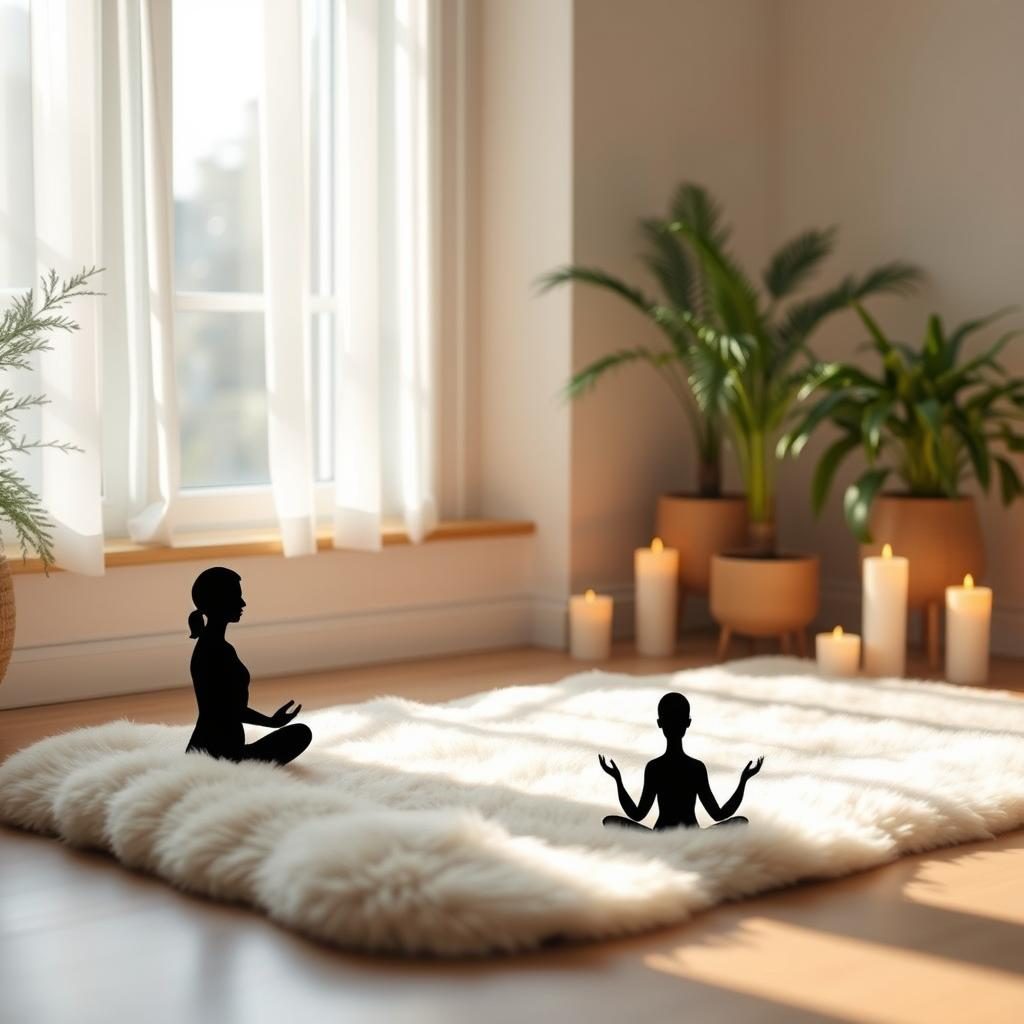Paramahansa Yogananda said, “Meditation is the science of the soul.” This quote shows the heart of spiritual meditation practice. It invites us to find a deeper connection within. I learned that spiritual meditation is a powerful tool for growth and better emotional health.
This guide is here to help you start your spiritual meditation journey. You’ll learn how to set your goals and practice key techniques. Starting with just five minutes of meditation twice a day can open doors to new insights.
We’ll explore the basics of spiritual meditation together. We’ll talk about starting small and trying different methods to make your practice richer. Let’s start this journey to better self-awareness and healing together.
Key Takeaways
- Understanding spiritual meditation is key for personal growth and emotional balance.
- Begin with 5-minute sessions, then move to 30 minutes twice a day.
- Add small rituals, like lighting incense and saying thanks, for a richer experience.
- Learn to ignore distractions to improve your focus during meditation.
- Use apps like “Insight Timer” and “Headspace” for guided meditation.
- Pay attention to physical feelings, like in your belly and nostrils, to deepen your awareness.
- Think about finding a teacher or group for support in your meditation journey.
Understanding Spiritual Meditation
Many people want to know more about spiritual meditation. It’s not just regular meditation. It connects us to a bigger universe. For thousands of years, it has helped people feel better in body, mind, and soul.
Every meditation journey is different. It shows how we grow and learn about ourselves.
What is Spiritual Meditation?
At its heart, spiritual meditation is a way to explore our inner world. It helps us connect with our true selves and the universe. It’s about finding peace and understanding life’s mysteries.
This kind of meditation is different from others. It focuses on deeper truths and inner peace.
The Purpose of Spiritual Meditation
The main goal of spiritual meditation is to reach deeper states of being. It helps us deal with life’s challenges. It brings calm, emotional strength, and clear thinking.
It’s not just about healing ourselves. It also teaches us to care for others. Learning to forgive and release negative feelings is key to growing spiritually.
How It Differs from Other Meditation Practices
Understanding the differences between meditation types shows what makes spiritual meditation special. Mindfulness and zen meditation aim to increase awareness. Spiritual meditation goes deeper, often using prayer and contemplation.
This journey takes time and effort. It’s more than just sitting quietly. It’s a journey of growth and change.
Benefits of Spiritual Meditation
Spiritual meditation brings many benefits to our lives. It improves our physical health, emotional and mental well-being, and spiritual growth. Knowing these benefits helps me make my meditation better and reach my goals.
Physical Health Benefits
Regular meditation is good for our bodies. It can help with high blood pressure, diabetes, and heart issues. I’ve seen it improve my sleep and lower stress, making me feel more energetic and balanced.
Mental and Emotional Benefits
Meditation boosts our mental clarity and emotional strength. It reduces anxiety and helps us behave better. It makes us happier and more joyful, and helps us connect with others deeply.
Spiritual Growth and Awareness
Meditation also grows our spirituality. It connects us to a higher power and helps us understand life better. This journey makes us more grateful, compassionate, and creative.

How to Start Spiritual Meditation
Starting spiritual meditation is a journey of discovery. First, setting intentions is key. It helps focus my energy and clarity. This purpose keeps me grounded and present.
Setting Your Intentions
Setting intentions is crucial in starting spiritual meditation. Choosing my focus shapes my meditation. Writing down or silently repeating my intentions helps me stay focused.
This clarity strengthens my dedication. It leads to deeper insights and emotional healing.
Choosing a Suitable Space
The space I choose affects my meditation quality. A quiet, calming space is best. I prefer a cozy corner in my home.
It’s filled with plants, soft fabrics, and gentle lighting. This space becomes my sanctuary. It promotes relaxation and peace.
Essential Equipment and Comfort
While I can meditate anywhere, some equipment makes it better. A comfy cushion or mat is essential. It helps me relax fully.
Soothing music or sounds add to the atmosphere. Personal items like crystals or sacred texts deepen my connection. They bring a sense of contentment.

Beginner Meditation Techniques
Exploring beginner meditation techniques opens the door to a more mindful and serene lifestyle. Starting with basic breathing techniques allows me to focus on my breath. This cultivates calmness and clarity.
By centering my attention on inhalation and exhalation, I can quiet my mind. This fosters relaxation.
Basic Breathing Techniques
Focusing on basic breathing techniques is an effective way to begin my meditation journey. I can try the following steps:
- Find a quiet space where I feel comfortable.
- Sit or lie down in a position that feels natural.
- Inhale deeply through my nose, allowing my abdomen to rise.
- Exhale slowly through my mouth, feeling my body relax.
This process helps me build the muscles of attention and mindfulness. Regular practice can enhance my focus and lower stress levels over time.
Present Moment Focus Meditation
Present moment meditation is another foundational technique for beginners. This practice encourages me to anchor my thoughts in the here and now. I can train my mind to let go of distractions about the past or future.
Here are some methods to embrace present moment meditation:
- Observe my surroundings quietly, noting colors, sounds, and sensations.
- Pay attention to each breath, acknowledging thoughts without judgment.
- Engage in mindful walking, feeling each step with intention.
These practices deepen my awareness. They push me towards experiencing life fully, one moment at a time.
Using Guided Meditations for Beginners
For those just starting out, guided meditation for beginners offers a helpful framework. I can benefit from instructions provided by experienced practitioners. This structured approach makes it easier for me to relax and absorb the practice without feeling overwhelmed.
I can find various resources, such as:
- Mobile meditation apps like Headspace or Calm.
- Online platforms with guided sessions available for free.
- Local meditation centers offering classes and workshops.

Incorporating these beginner meditation techniques effectively sets the foundation for a lasting meditation habit. By exploring basic breathing techniques, present moment meditation, and engaging with guided sessions, I can cultivate a deeper sense of mindfulness in my daily life.
Creating a Regular Meditation Routine
Starting a regular meditation routine is key to enjoying its benefits. It’s vital to pick a time that fits into your life. This could be in the morning, at lunch, or before bed. Finding the right time makes meditation a natural part of your day.
Choosing the Right Time of Day
Morning meditation is often peaceful, making it easier to focus. Starting your day with mindfulness can calm your mind. Lunchtime meditation can refresh you, while evening sessions help you unwind.
Choosing the right time helps you stay consistent. This consistency is crucial for growth.
Consistency Over Duration
Being consistent in meditation is more important than long sessions. Short daily meditation, about 20 minutes, can be more effective. Start small and increase time as you get more comfortable.
Incorporating Meditation into Daily Life
Making meditation a part of your daily activities helps a lot. Mindful driving or deep breathing breaks are great for reflection. Adding mindfulness to tasks like showering or eating makes meditation a regular habit.
Tips for Starting Your Meditation Practice
Starting meditation can be both exciting and challenging. Beginners often face hurdles, but the right approach helps. Understanding these challenges makes meditation more rewarding. Here are some strategies that have helped me a lot.
Overcoming Common Challenges
Distractions and self-doubt are common during meditation. Accepting these feelings helps me stay focused. Here are some tips to overcome common hurdles:
- Start with short meditation sessions, around 5 minutes, to build confidence.
- Designate a peaceful space, free from disturbances, which can enhance the experience.
- Allow feelings to flow during meditation without engaging in thoughts about them.
Staying Motivated and Committed
Staying motivated in meditation is key for consistent practice. Exploring different meditation styles keeps things interesting. Here are some tips to keep me inspired:
- Explore different meditation styles to keep things fresh and engaging.
- Establish a regular meditation time that aligns with personal preferences, whether in the morning for clarity or evening for relaxation.
- Utilize meditation apps like Insight Timer to access guided sessions, which many beginners find beneficial.
- Keep visual reminders or inspiring quotes in your meditation space to reinforce commitment.

| Challenge | Solution |
|---|---|
| Distractions | Choose a dedicated meditation space. |
| Self-doubt | Start with shorter sessions to boost confidence. |
| Lack of Time | Integrate mindfulness into daily routines. |
By applying these insights, I have had more fruitful meditation sessions. Overcoming challenges is part of the process. Staying committed makes meditation a meaningful habit. With time and practice, anyone can enjoy meditation’s benefits.
Resources for Further Learning
I’ve found many resources to help me learn more about spiritual meditation. Books by Thich Nhat Hanh and Sharon Salzberg are full of wisdom. They offer great advice and help me grow in my meditation practice.
Platforms like Headspace and Calm are also key for me. They offer guided meditation sessions that help me learn and stay on track. Podcasts and YouTube channels about meditation add more to my knowledge, showing me different ways to meditate.
For a more structured learning, there are specific resources for spiritual meditation. The Insight Meditation Center offers courses and teachings by Joseph Goldstein. These resources help me improve my practice and grow spiritually.







